I still keep my Komsomol card
author
Ida Shek
Ida Sheck comes from a high-ranking Soviet family, i.e. they were part of the “nomenklatura”. She and her husband, Ruben, who was also a Party member, were both engineers hodling key administrative positions within the Soviet system, which guaranteed numerous benefits. The Shecks were usually among the first on the waiting lists to buy a car or a country house. Since the 1970s, Ruben was able to travel abroad regularly, a rare privilege for a Soviet citizen, so he could bring Western goods back home.
Postcard
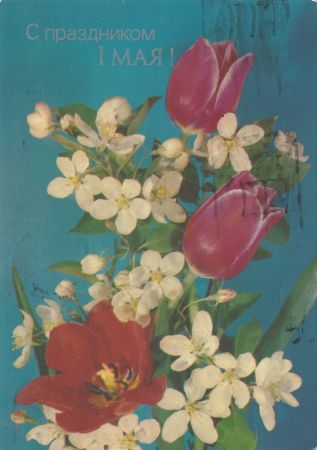
- 1st of May
- The 1st of May, the Day of International Solidarity of the Working Class, or Soviet Labour Day, was celebrated in all the republics of the Soviet Union from 1919 to 1990. Every city or village organized a parade: flags were carried, posters and banners were put up, kids had red ballons and portraits of the nation’s rulers were on display.
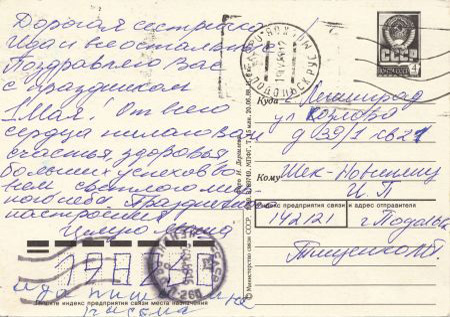
- Podolsk, USSR, May 1st
- Podolsk, USSR, May 1st. In Soviet times Podolsk was one of the major industrial centres of Moscow Oblast. In 1971 the city was awarded the Order of the Red Banner of Labour.
- Leningrad
- To: Mr. and Mrs. Sheck, Leningrad, USSR. Ida used to receive many postcards on the 1st of May as, in addition to being a national holiday, it was also her son's birthday.
- Postcard Text
- Dear sister Ida and all your family, all my greetings for the 1 st of May. With all my heart I wish you happiness, health, great success, peace, and all the best. Love. Masha.
personal archives
Nomenklatura
Ida and her family.
country: Soviet Union / year:
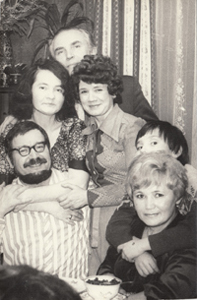
Ida and her family. Ida and her husband, engineers, both came from high-ranking administrative families. Her uncle was a general in the air force, and she worked as an engineer in a controlled-access aviation enterprise. Ruben Sheck, her husband, also worked as an engineer, in the military industry with a high-ranking security permit. They were both Communists, as it would have been impossible to have career like she and her husband had, without joining the Party.
Sadovodstvo, the Gardening establishment.
Ida in the gardens of the Sadovodstvo.
country: Soviet Union / year:
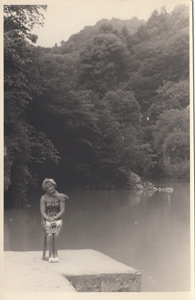
Ida in the gardens of the Sadovodstvo. In the mid-1980s, the government sold small plots of land to people from the cities. Here, they could grow what they needed to feed themselves. Ida and her husband bought land near swamps and built a dacha. It became both a food supply and their country house. "Gardening" became a sort of cultural movement in the 1980s and replaced travel for many people.
Gifts from the West
Ida wearing a west fashion dress.
country: Soviet Union / year:
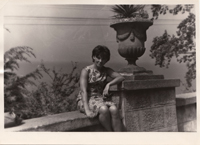
Ida wearing a dress in Western fashion. Ida's husband Ruben got a state prize for his work and was sent to France in 1977 on a work visa. He described his first visit to Paris as an “emotional earthquake”. He went back to France several times between 1977 and 1978 and brought back goods they couldn’t find in USSR, mostly fashionable clothes and hard-to-find fabrics like mohair or polyester.
Home
Ida sitting at the table
country: Soviet Union / year:
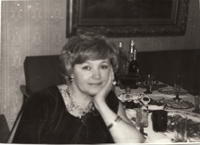
Ida sitting at the table. Shortage was a great problem in the USSR and many goods were available only to the members of the élite, the so called "nomenklatura", like Ida's family. Thanks to her connections, Ida was also able to get the special "checks" to buy foreign goods in the Berezkas (Little birch), closed shops where one could find rare goods.
In the streets of Leningrad
Family portrait in Leningrad at the beginning of the 80s
country: Soviet Union / year:
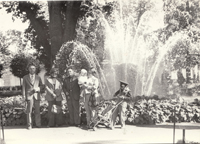
Family portrait in Leningrad at the beginning of the 80s. From left to right : Ida’s husband, Ida, Lev Fomin, Elena Fomina with Polina Fomina on her hands, Ruben Ida’s son. As members of the nomenklatura Ida and her family had several privileges like access to western fashion clothes and special restaurants. They also got free pass to museums and special cultural visits, like the exhibit of foreign painters as Gauguin or Delacroix.